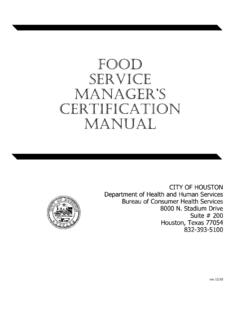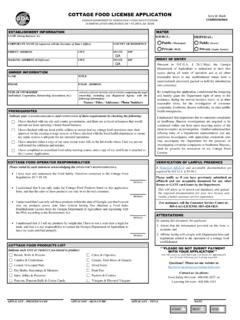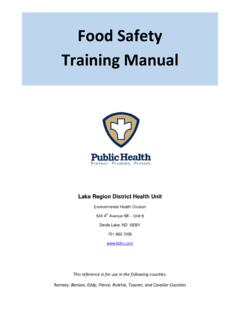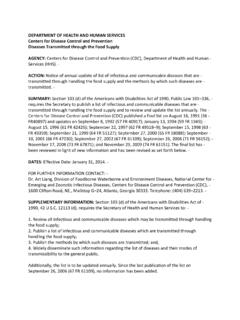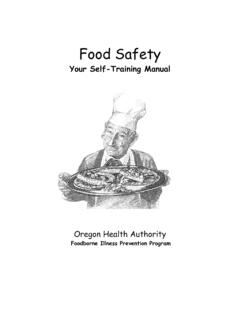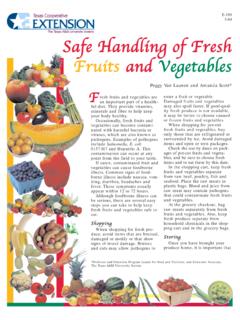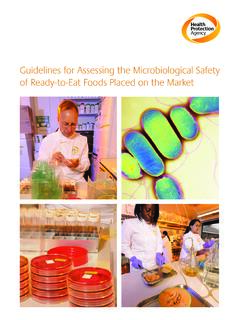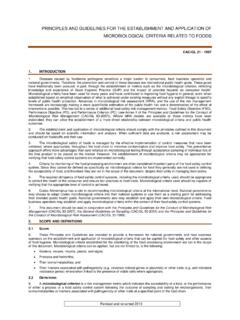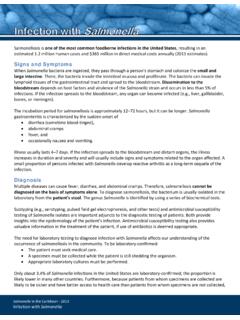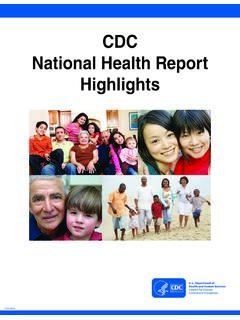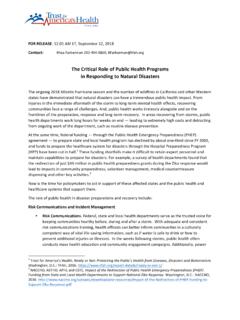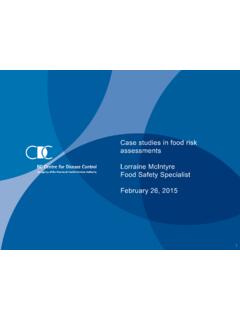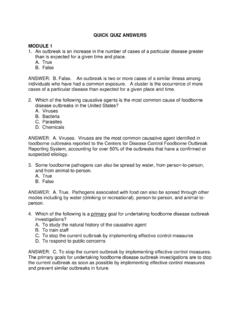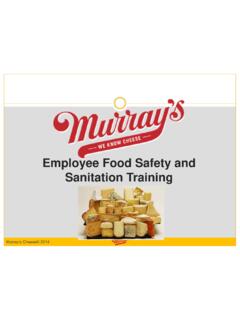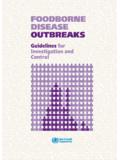Search results with tag "Foodborne"
WHO ESTIMATES OF THE GLOBAL BURDEN OF FOODBORNE …
apps.who.intSalmonella enterica (NTS, which causes diarrhoeal and invasive disease). Other major causes of foodborne deaths were Salmonella Typhi, Taenia solium, hepatitis A virus, and aflatoxin. The global burden of foodborne disease by these 31 hazards was 33 (95% UI 25–46) million DALYs in 2010; 40% of the foodborne disease
FOOD SERVICE MANAGER’S CERTIFICATION MANUAL
www.houstontx.govFOODBORNE ILLNESS A foodborne illness is an infection or illness carried or transmitted to people by food containing harmful substances. TYPES OF FOODBORNE ILLNESS 1. Foodborne infection is caused by eating food contaminated with microorganisms and once in the body, the organisms continue to reproduce and cause illness. Bacteria causing infections
Preventing Foodborne Illness: Bacillus cereus
nifa.usda.govOne of the easiest ways to prevent foodborne illness as-sociated with B. cereus is by ensuring that foods are cooked thoroughly and cooled rapidly. One of the leading causes of foodborne infections and intoxications by B. cereus is the improper holding of cooked foods. Refer to sections 3-401.11 to 3-401.14 and 3-403.11 of the 2013 Food Code.
Preventing Foodborne Illness: Clostridium botulinum
nifa.usda.govPreventing Foodborne Illness: Clostridium botulinum 2 2. Infant botulism occurs when infants (less than one year of age) ingest C. botulinum spores, which then germinate and produce the botulinum toxin in the intestines. In addition, this is the most common form of botulism,
Food Preparation, Food Safety & Sanitation NOTE: This ...
ucanr.eduIs Foodborne Illness Common? In the United States, during 2011 it was estimated that… 48 million people were affected by foodborne illness. 128,000 people were hospitalized. 3,000 people died. Source: Centers for Disease Control, 2011
COTTAGE FOOD LICENSE APPLICATION Gary W. Black
agr.georgia.gov, foodborne disease outbreaks, or other public health emergencies. I understand that inspections due to consumer complaints or foodborne illnesses investigations are required to be conducted within one hour upon receiving notice of the intent to conduct an investigation. I …
Food Safety Training Manual
rcphd.comFoodborne illness is caused by eating contaminated foods or beverages. Foods can become unsafe by things you cannot see, smell or taste. There are three main types foodborne hazard: Physical, Chemical, and Biological. 1. Physical – Caused when a foreign object enters the food and is eaten causing injury.
Preventing Foodborne Illness: Clostridium perfingens
nifa.usda.govPreventing Foodborne Illness Associated with Clostridium perfringens1 Keith R. Schneider, Renée Goodrich-Schneider, Ploy Kurdmongkoltham, and Bruna Bertoldi2 1. This document is FSHN035, one of a series of the Food Science and Human Nutrition Department, UF/IFAS Extension. Original publication date April 2003.
Alberta Food Safety Basics Booklet
www.albertahealthservices.ca6 FACTS Food that contains harmful microbes (germs) or their toxins (poison) may look, taste, and smell normal. In many cases, foodborne illness is not caused by the last meal or food eaten. It can take time for symptoms to develop. With E. coli O157:H7 infection (a type of foodborne illness), it can take 2-10 days for the signs of illness to appear.
Diseases Transmitted through the Food Supply
www.cdc.gov11. Lynch M, Painter J, Woodruff R, Braden C. Surveillance for foodborne-disease outbreaks—United States, 1998–2002. MMWR Morb Mortal Wkly Rep 2006;55:1–34. 12. Food and Drug Administration. FDA report on the occurrence of foodborne illness risk factors in selected institutional foodservice, restaurant, and retail food store facility
Food Handler Basic Course Study Guide
1fceebb378f17f2f1c11-f1e651d08cdf8808be46de51b20524c3.ssl.cf5.rackcdn.comThe concept of foodborne illness will be introduced. The training will address personal hygiene, contamination, and temperature control to reinforce the food handler’s behaviors, which can prevent foodborne illness. Section 1.1 Employee Illness • The food handler will know to call the person in charge at the food service
Your Own Health Comes First - Oregon
www.oregon.govThe concept of foodborne illness will be introduced. The training will address personal hygiene, contamination, and temperature control to reinforce the food handler's behaviors, which can prevent foodborne illness. Employee Illness . 1. The food handler will …
The “BIG 5” Foodborne Illnesses
www.myfloridalicense.comThe “BIG 6” Foodborne Illnesses Hepatitis A Overview: Fecal-oral transmission, can be found in water and raw shellfish (oysters, clam, mussels), highly infectious; disease can be spread 2-4 weeks before any symptoms appear, children may show no symptoms but still spread the disease to others Prevention:
Safe Handling of Fresh Fruits and Vegetables
foodsafety.wisc.edupathogens. Examples of pathogens include Salmonella, E. coli 0157:H7 and Hepatitis A. This contamination can occur at any point from the field to your table. If eaten, contaminated fruit and vegetables can cause foodborne illness. Common signs of food-borne illness include nausea, vom-iting, diarrhea, headaches and fever. These symptoms usually
Guidelines for Assessing the Microbiological Safety of ...
assets.publishing.service.gov.ukEnforcement Officers. These revised guidelines supersede those previously issued and have a different emphasis focusing on public health and consumer protection. Additional information on the bacteria that cause foodborne disease and those that act as hygiene indicators, on interpretation of test results, comments on
PRINCIPLES AND GUIDELINES FOR THE ESTABLISHMENT AND ...
www.fao.orgDiseases caused by foodborne pathogens constitute a major burden to consumers, food business operators and national governments. ... Microbiological criteria should be established based on knowledge of the microorganisms and their occurrence and ... Verifying that the selected control measures are meeting POs and/or FSOs. v) Providing ...
Signs and Symptoms small and Dissemination to the
www.cdc.govone of the most common foodborne infections in the United States ... integrating enteric disease surveillance programs are critical to . Salmonella control efforts. By examining results of Salmonella subtyping from food animals, environmental samples, and humans, public health officials can draw conclusions about sources of human infection and ...
CDC National Health Report Highlights
www.cdc.govc. Foodborne Illnesses..... 13 This report offers practical dashboards that highlight America’s recent progress in combatting the leading causes of death and key risk and protective factors impacting our nation’s health. Progress for each indicator was …
Healthy food - who.int
www.who.intCONTENTS SUMMARY 1 INTRODUCTION 3 WHY HEALTHY FOOD MARKETS? 5 need for a food safety approach 5 special character of food markets 7 What are major foodborne hazards?
The Critical Role of Public Health Programs in Responding ...
www.tfah.orgdetect and contain public health threats, including mosquito-borne illnesses, foodborne outbreaks and other health threats that can emerge following a natural disaster. CDC programs such as the epidemiology and laboratory capacity program, vector-borne diseases, and advance
Case studies in food risk assessments Food Safety Specialist
www.ncceh.caBeuchat LR, Komitopoulou E, Beckers H, et al. Low Water Activity Foods: Increased Concern as Vehicles of Foodborne Pathogens. Journal of Food Protection. 2013;76(1):150- 72.
Preface - Centers for Disease Control and Prevention
www.cdc.govtoxin. Foodborne botulism results from the ingestion of food containing preformed toxin. Wound botulism is caused by organisms that multiply and produce toxin in a contaminated wound. Infant botulism is due to the endogenous production of toxin by germinating spores of C. botulinum in the intestine of the infant.
Quick Quiz Answers (New Jersey) - NEHA
www.neha.orgAnswer: A. Detects all types of foodborne illness. For pathogen-specific surveillance, cases of interest are specific laboratory-confirmed diseases or well-defined syndromes selected by the state or local health department. 5. All of the following are important roles for local health departments in national pathogen-specific surveillance EXCEPT
Consuming raw or undercooked food may increase your risk ...
www.legoland.comConsuming raw or undercooked food may increase your risk of foodborne illness, especially if you have a medical condition Please let us know if you have any food allergies as not all ingredients are listed on the menu. ©2021 The LEGO Group.
** Consuming Raw Or Undercooked Meats, Poultry, Seafood ...
coplayeatery.com** Consuming Raw Or Undercooked Meats, Poultry, Seafood, Shellfish Or Eggs May Increase Your Risk Of Foodborne Illness, Especially If You Have Certain Medical Conditions sliced roasT TurKey or sliced roasT beef 5.45 virGinia ham 5.35 Tuna or chicKen salad 5.30 eGG salad 4.99 cold meaTloaf 5.55 b l T 5.50 bacon, lettuce, tomato hoT doG 3.25
BEGINNINGS SALADS
www.goldennugget.com*NOTICE: Consuming raw or undercooked meats, poultry, seafood, mollusk, or eggs may increase the risk of foodborne illness. Chart House is …
Appendix 1 - nraweb.vo.llnwd.net
nraweb.vo.llnwd.netAppendix A.1 Organisms That Cause Foodborne Illness Bacteria Bacteria Bacillus cereus (ba-SIL-us SEER-ee-us) Illness Bacillus cereus gastroenteritis (ba-SIL-us SEER-ee-us GAS-tro-EN-ter-I-tiss) Bacillus cereus is a spore-forming bacteria found in dirt. It can produce two different toxins when allowed to
Understanding Food-Grade Compressed Air Standards: Guide ...
www.foodprocessing.comUnderstanding Food-Grade Compressed Air Standards: Guide to Preventing Risks at Your Plant by Jeff Fletcher, FS-Elliott Co., LLC Page 3 Food Safety Laws and Prevention Throughout the world, food safety organizations are enhancing their efforts to reduce cases of foodborne illness and safety recalls in the form of several updated and refreshed
Employee Illness Log - Minnesota Department of Health
www.health.state.mn.usEmployee Illness Log Employees are required to notify the person in charge (PIC) of their symptoms and pathogens that could cause foodborne illness. The PIC is required to record all reports of diarrhea or vomiting made by employees, and report the illness upon request.
Compendium of Microbiological Criteria for Food
www.foodstandards.gov.auassociated with foodborne illness caused by V. parahaemolyticus. V. parahaemolyticus occurs in coastal and estuarine waters and is a natural contaminant of seafood. Initial levels will depend on environmental factors at harvest. Illness is associated with eating raw or lightly cooked seafood, or cooked seafood that has been cross contaminated.
This 2007 version of FSIS recognizes it since it was ...
meathaccp.wisc.eduTompkin, R.B. 1996. The Significance of time-temperature to growth of foodborne pathogens during refrigeration at 40-50°F. Presented during the Joint FSIS/FDA Conference on Time/Temperature. November 18, Washington, DC. Attribution on page 11 of this document.From the author: 12/31/2015 -This 2007 version of
Employee Food Safety and Sanitation Training
www.cheesesociety.orgFoodborne Illness Risk Factors 1. Improper Holding 2. Poor Personal Hygiene 3. Inadequate Cooking 4. Contaminated Equipment 5. Food from Unsafe Sources Key Interventions 1. Demonstration of Knowledge 2. Employee Health 3. Time/Temperature 4. Hands a vehicle of contamination 5. Consumer Advisory
Table 1. Minimum growth temperatures for selected ...
meathaccp.wisc.eduTable 1. Minimum growth temperatures for selected foodborne pathogens. Minimum Growth Temperatures Salmonellae1 Pathogenic E. coli L. monocytogenes Y. enterocolitica Campylobacter jejuni Staphylococcus aureus Bacillus cereus2 psychrotrophic strains Clostridium perfringens Clostridium botulinum nonproteolytic proteolytic 7C 7-8C -0.4C -1.3C 32C 7C
Staphylococcus aureus - Food Standards
www.foodstandards.gov.au0.03 (CDC 2012). It is estimated that in the US, S. aureus accounts for 2.6% of foodborne illness caused by 31 major pathogens (Scallan et al. 2011). The incidence of staphylococcal food poisoning is seasonal. Most cases occur in the late summer when temperatures are warm and food is stored improperly (Montville and Matthews 2008).
sanitation and safety
resources.escoffier.eduMost foodborne diseases are caused by bacteria, so most of our attention in this chapter is focused on them, but the other types can be dangerous as well. ... each kind of bacterial pathogen causes disease in one of three ways: 1. Intoxications are caused by poisons (toxins) the bacteria produce while they are growing
Microbiological hazards in fresh fruits and vegetables
www.who.intfoodborne pathogens. Level 2 Priorities – berries, green onions, melons, sprouted seeds, tomatoes These commodities were identified as being the second highest concern. Given the available knowledge, berries, green onions, melons and …
Foodborne Disease Outbreaks
www.doh.wa.gov3. FOODBORNE DISEASE OUTBREAK DEFINITIONS . A FBD. outbreak. is defined as an incident in which 1) two or more persons experience a similar illness after exposure to the same food source and 2) epidemiologic evidence implicates food as the likely source of the illness. (See . Appendix A for more detailed definitions).
Foodborne disease outbreaks: Guidelines for investigation ...
www.who.intfoodborne diseases cause gastroenteritis, food does represent an important vehicle for pathogens of substantial public health significance. A number of studies are under way that aim to provide a better understanding of the global public health burden of gastroenteritis and
Foodborne Illness Chart - FOODSAFE
www.foodsafe.cafoods, especially hamburger Giardiasis lamblia (infection) abdominal pain; diarrhea; fever; cramps 1 week water; raw vegetables and fruits Hepatitis A (infection) fever; anorexia; nausea; abdominal pain; jaundice 15 to 50 days shellfish; contaminated water; any food contaminated by the feces, urine or blood of infected humans and other primates
Similar queries
Foodborne, Salmonella enterica, Salmonella, Foodborne illness, Illness, Organisms, Causing, Preventing Foodborne Illness: Clostridium, Sanitation, COTTAGE FOOD LICENSE APPLICATION, Preventing Foodborne Illness, Report, Oregon, Pathogens, Food-borne, Guidelines for Assessing the Microbiological Safety of, Guidelines, Foodborne disease, Foodborne pathogens, Occurrence, Selected, Integrating, Disease surveillance, Health, Food safety, Illnesses, Studies in food risk assessments, Centers for Disease Control and Prevention, Quick Quiz Answers, Pathogen, Of Foodborne, Foodborne illness. Chart, Preventing, Minnesota Department of Health, Associated, Minimum growth temperatures for selected, Minimum growth temperatures for selected foodborne pathogens, Foodborne Disease Outbreaks, Foodborne Illness Chart, Foods

